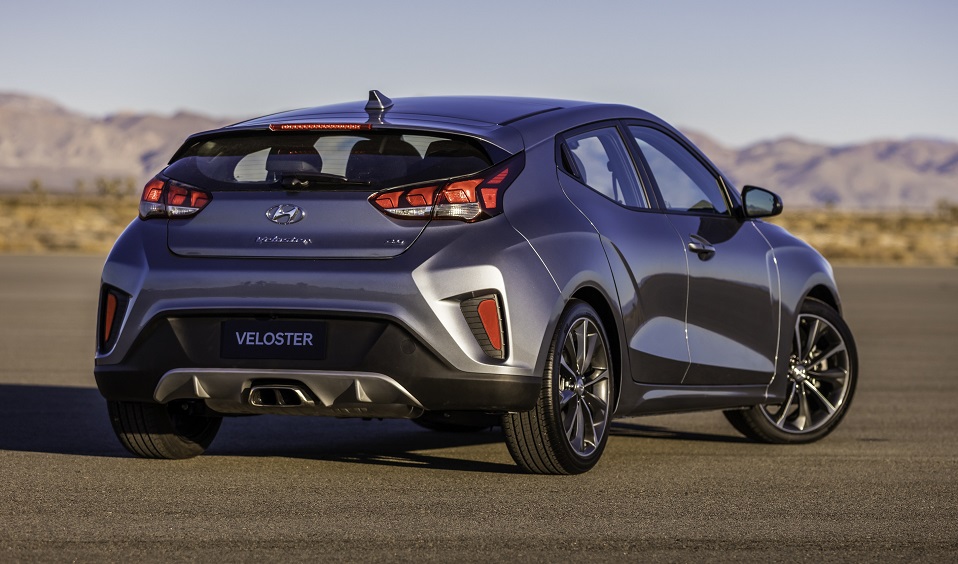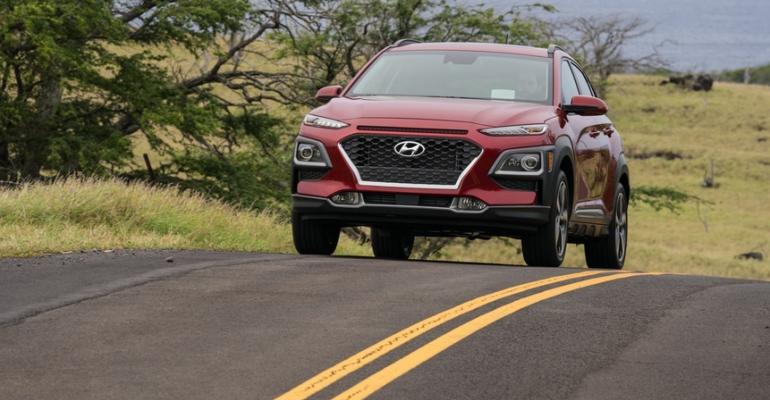DETROIT – With its U.S. sales down 7.1% January through May, it may seem as if Hyundai is headed for another calendar year in negative territory.
But a senior Hyundai U.S. official says if all goes according to plan, the brand will close 2018 in the black, with about a 10% increase in volume as new models launch.
“(The new small) Kona (CUV) didn’t go on sale until the middle part of March and much of the new product onslaught is coming in the second half of the year,” Brian Smith, chief operating officer-Hyundai Motor America, tells media here yesterday at a ’19 Veloster briefing.
May ended a long losing streak for Hyundai U.S. sales. Its 7.2% daily-selling-rate spike was the brand’s first month of year-on-year growth since December 2017, Wards Intelligence data shows. Smith credits May’s performance to its utility vehicles: the Kona as well as the compact Tucson and midsize Santa Fe CUV.
Those three models collectively boosted the brand’s light-truck volume 27.2% through May vs. like-2017, although it wasn’t enough to offset the 22.3% decline in Hyundai’s car sales in the year’s first five months.
Although Hyundai still is one of the few brands in the U.S. selling a higher ratio of cars than light trucks (it had a 57% car/43% light-truck ratio through May vs. the total light-vehicle industry ratio last month of 32% car/68% light-truck), Smith expects things to even out by the end of the year largely thanks to a new-generation Santa Fe launching this summer. Increased volume of the Kona and a refreshed Tucson also should help.
May sales were about 46% light-truck and “by the end of this year we’re going to be getting pretty close to 50/50,” Smith says.
Of the Kona, Smith claims it is ramping up faster than some of its competitors have. Sales went from roughly 2,360 in March to 3,315 in April to 5,079 in May.
However, while Kona’s May sales outdid the Toyota C-HR’s (4,366) and a few other lower-volume competitors, it placed low in Wards Intelligence’s Small CUV segment, well behind the Jeep Compass (17,327), the group’s best-seller last month.
Still, Smith notes whatever its volume, the Kona is bringing in buyers new to Hyundai. Almost 60% of Kona buyers are new to the brand, he says.
The small CUV is not the only new or refreshed Hyundai coming this year.
Besides the Santa Fe and Tucson, a second-gen Veloster sport coupe is launching this quarter (see '19 model lower right), and Hyundai’s next-generation fuel-cell CUV, the Nexo, replacing the current Tucson FCV, launches this fall.
While the Veloster isn’t a big seller for Hyundai, Smith notes its first generation was successful pulling in new buyers.
 “When you look at those early buyers with the first-generation Veloster, a little over half of them had never considered a Hyundai before, and 70% of those buyers replaced a vehicle that was not a Hyundai-brand car,” he says, citing a 2012 Hyundai study. Smith adds another 15% of those who bought a first-gen Veloster added a vehicle to their household, so in total 85% of the car’s buyers were new to Hyundai.
“When you look at those early buyers with the first-generation Veloster, a little over half of them had never considered a Hyundai before, and 70% of those buyers replaced a vehicle that was not a Hyundai-brand car,” he says, citing a 2012 Hyundai study. Smith adds another 15% of those who bought a first-gen Veloster added a vehicle to their household, so in total 85% of the car’s buyers were new to Hyundai.
The first-gen Veloster, which went on sale in late 2011 as a ’12 model, also attracted a younger buyer with higher household income, both holy grails for most automotive brands.
A high-performance Veloster, the Veloster N and part of Hyundai’s new global N (N standing for its Namyang, South Korea, R&D center) brand, is due this fall.
Smith says, per the 2012 study, Veloster buyers’ median age was 49 compared with 55 for the overall Hyundai brand, while median household income was $81,000 vs. $74,000 for the brand.
Wards Intelligence’s Small Specialty Car segment was down 32.0% to 30,823 through May, with the group’s 12 models all falling this year. Group sales went from 193,363 in 2012 to 93,723 last year due to the discontinuation of the Mitsubishi Eclipse, Scion tC, Smart Fortwo and Volkswagen Beetle. Wards Intelligence forecasts the group to continue decline into the next decade, although sales should stabilize in the mid 50,000-unit range starting in 2023.
Meanwhile, with a better car/light-truck mix, Smith says the Korean brand is turning its attention to being – using its advertising tagline – “a great deal more than the great deal.” The new tagline is an effort to shift brand perception away from traditional positioning as merely a good value, he says.





